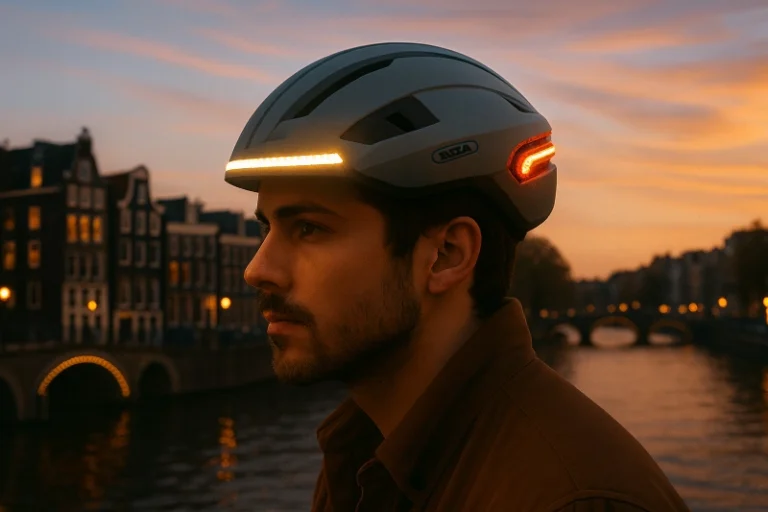De wereld ondergaat een transformatie op het gebied van mobiliteit, en elektrische motoren zijn de drijvende kracht achter deze verandering. Deze innovatieve technologie biedt een krachtige en milieuvriendelijke oplossing voor stedelijk vervoer. Door de toenemende vraag naar efficiënte en emissievrije voertuigen, spelen elektrische motoren een cruciale rol in het revolutioneren van de manier waarop mensen zich door steden bewegen.
Elektrische motoren beschikken over een unieke combinatie van kracht en duurzaamheid, waardoor ze een aantrekkelijk alternatief vormen voor traditionele verbrandingsmotoren. Met hun stille werking en zero-emissie-profiel dragen ze bij aan een schonere en leefbaardere stedelijke omgeving. Deze technologie opent deuren naar nieuwe mogelijkheden voor een duurzamer mobiliteitsaanbod, waarbij de focus ligt op een betere luchtkwaliteit, verminderde geluidsoverlast en een kleinere ecologische voetafdruk.
Key Takeaways
- Elektrische motoren bieden een krachtige en milieuvriendelijke oplossing voor stedelijk vervoer.
- De stille werking en zero-emissie-profiel van elektrische motoren dragen bij aan een schonere en leefbaardere stedelijke omgeving.
- Elektrische mobiliteit opent deuren naar nieuwe mogelijkheden voor duurzaam vervoer in steden.
- Elektrische voertuigen hebben een kleinere ecologische voetafdruk dan traditionele verbrandingsmotoren.
- Elektrische motoren zijn een belangrijke drijvende kracht achter de transformatie van mobiliteit in de stad.
What Are Electric Motors?
Electric motors are the unsung heroes powering our modern world. These remarkable devices convert electrical energy into mechanical force, enabling a wide range of applications, from powering industrial machinery to propelling electric vehicles. Understanding the basics of how electric motors work is crucial in unlocking their remarkable benefits and their role in driving a more eco-friendly and emissions-free future.
Understanding the Basics
At the heart of an electric motor lies a simple principle: when an electric current flows through a coil of wire, it generates a magnetic field. This magnetic field interacts with the fixed magnets within the motor, causing the coil to spin. By precisely controlling the flow of electricity, electric motors can transform this rotational force into useful mechanical power.
Benefits of Electric Motors
- Energy Efficiency: Electric motors are renowned for their exceptional energy efficiency, converting up to 90% of the input electrical energy into useful mechanical work, far outpacing traditional internal combustion engines.
- Eco-Friendly Operation: Unlike fossil fuel-powered engines, electric motors are emissions-free, making them a crucial component in the drive towards sustainable, eco-friendly transportation and industrial processes.
- Low Maintenance: With fewer moving parts and no need for regular oil changes or tune-ups, electric motors require significantly less maintenance compared to their internal combustion counterparts.
“The transition to electric motors is not just a technological shift, but a fundamental transformation in how we power our world, ushering in a cleaner, more sustainable future.”
By understanding the basics of electric motors and the remarkable benefits they offer, we can unlock their full potential in driving a greener, more energy-efficient tomorrow.
The Rise of Electric Vehicles
In recent years, the world has witnessed a remarkable surge in the adoption of electric vehicles. As concerns over sustainable transportation and urban mobility have grown, electric vehicles have emerged as a viable and attractive solution, spearheading a revolution in clean energy mobility.
The rise of electric vehicles can be attributed to several key factors. Advancements in battery technology have significantly improved the range, performance, and affordability of these eco-friendly alternatives, making them increasingly appealing to city dwellers. Government incentives and policies, such as tax credits and emissions regulations, have also played a crucial role in driving the widespread adoption of electric vehicles.
Furthermore, the growing environmental consciousness among consumers has fueled the demand for cleaner modes of transportation. Concerned about the environmental impact of traditional gasoline-powered vehicles, many urban residents have embraced electric vehicles as a means to reduce their carbon footprint and contribute to a more sustainable future.
| Metric | Traditional Vehicles | Electric Vehicles |
|---|---|---|
| Fuel Efficiency | 25-35 MPG | 100-130 MPGe* |
| Emissions | High | Zero |
| Maintenance Costs | $1,200-$2,000 per year | $600-$900 per year |
As the electric vehicle market continues to expand, cities around the world are embracing this clean, efficient, and sustainable mode of transportation, paving the way for a future where urban mobility is not only practical but also environmentally responsible.
“The rise of electric vehicles is a testament to our collective desire for a cleaner, more sustainable future. As technology advances and societal priorities shift, we are witnessing a fundamental transformation in the way we move through our cities.”
Elektrische motoren: Krachtig en groen door de stad
As the world becomes increasingly conscious of the need for sustainable mobility, the role of electric motors in shaping a greener urban landscape has come into sharp focus. These powerful yet eco-friendly motors are revolutionizing the way we move through our cities, offering a cleaner and more efficient alternative to traditional transportation methods.
Sustainable Mobility
Electric motors are at the heart of sustainable mobility solutions, enabling the development of electric vehicles, buses, and light rail systems that significantly reduce greenhouse gas emissions and noise pollution. By harnessing the power of electricity, these motors provide a clean and quiet mode of transportation that aligns with the growing demand for greener urban infrastructure.
Eco-Friendly Transportation
The adoption of electric motors in urban transportation has far-reaching benefits for the environment. They eliminate the direct emissions associated with fossil fuel-powered vehicles, contributing to improved air quality and a healthier living environment for city dwellers. This shift towards emission-free traffic not only reduces the carbon footprint but also enhances the overall livability and appeal of metropolitan areas.
| Metric | Conventional Vehicles | Electric Vehicles |
|---|---|---|
| Greenhouse Gas Emissions | High | Zero |
| Noise Pollution | Moderate to High | Low |
| Energy Efficiency | Low | High |
The integration of powerful and green electric motors into urban transportation systems is a pivotal step towards realizing a more sustainable and livable future for our cities.
Energy Efficiency and Cost Savings
Electric motors are revolutionizing the transportation industry, offering a more energy-efficient and cost-effective alternative to traditional internal combustion engines. As the adoption of electric vehicles continues to grow, the benefits of these advanced motors are becoming increasingly apparent, particularly in the realm of energy efficiency and cost savings.
Lower Operating Costs
One of the primary advantages of electric motors is their lower operating costs compared to their gas-powered counterparts. Electric vehicles (EVs) have fewer moving parts, which translates to reduced maintenance requirements and lower overall operating expenses. Additionally, the cost of electricity is generally more stable and predictable than the fluctuating price of gasoline, making the long-term costs of driving an EV more manageable for both individual consumers and sustainable transportation providers.
The energy efficiency of electric motors also contributes to significant cost savings over time. Electric motors convert a higher percentage of the energy they consume into useful work, minimizing energy waste and resulting in lower electricity bills for EV owners. This, coupled with the availability of various incentives and tax credits for EV purchases, makes electric vehicles an increasingly attractive and cost-effective option for those seeking to reduce their environmental impact while also enjoying the financial benefits.
“The lower operating and maintenance costs of electric vehicles can make them a more financially viable option for both individual consumers and public transportation providers.”
As the technology continues to advance and the infrastructure for electric vehicles expands, the cost-saving advantages of electric motors are poised to become even more pronounced, driving the widespread adoption of sustainable transportation solutions.
Emission-Free Urban Transportation
The electrification of urban transportation is a game-changer in the fight against air pollution and climate change. Electric motors, powering a growing fleet of electric vehicles and public transit systems, are revolutionizing the way we move through our cities. By eliminating tailpipe emissions, these emission-free technologies are contributing to cleaner air and a more sustainable urban transportation landscape.
The adoption of electric cars, buses, and light rail has a profound environmental impact. No longer do we have to contend with the harmful exhaust fumes and greenhouse gas emissions associated with traditional combustion engines. Instead, clean air and reduced carbon footprints are the new normal, paving the way for a greener, more livable urban future.
Beyond the obvious air quality improvements, the shift to emission-free transportation also supports broader sustainability efforts. By reducing our reliance on fossil fuels, we can mitigate the long-term effects of climate change and create more resilient, eco-friendly cities. This paradigm shift is empowering communities to rethink their transportation infrastructure and prioritize clean air and environmental impact as key considerations.
- Eliminating tailpipe emissions in urban areas
- Improving air quality and reducing greenhouse gas emissions
- Supporting broader sustainability efforts and climate change mitigation
- Enabling the creation of more livable, eco-friendly cities
As the world continues to urbanize, the role of emission-free urban transportation becomes increasingly crucial. Electric motors, powering a new generation of vehicles and public transit, are at the forefront of this transformation, paving the way for a cleaner, greener future for our cities.
Electric Motors in Public Transit
As the world becomes increasingly conscious of the need for sustainable transportation, the role of electric motors in public transit systems has gained significant attention. From buses to light rail, electric motors are transforming the way people move through urban environments, offering a greener and more efficient alternative to traditional diesel-powered vehicles.
Buses and Light Rail
Electric buses and light rail systems are emerging as the preferred choice for many cities committed to reducing their carbon footprint. These vehicles, powered by advanced electric motors, offer several benefits that make them an attractive option for public transit:
- Zero direct emissions, contributing to cleaner air and a healthier environment
- Quieter operation, providing a more pleasant and comfortable ride for passengers
- Lower maintenance costs due to the simplicity of electric motor technology
- Increased energy efficiency, leading to reduced operating expenses for transit authorities
The adoption of electric motors in public transit is not only beneficial for the environment but also enhances the overall user experience. Commuters can enjoy a smoother, more reliable, and more sustainable mode of transportation, making it a compelling choice for those seeking to reduce their carbon footprint and support their communities’ efforts towards a greener future.
| Modes of Public Transit | Benefits of Electric Motors |
|---|---|
| Buses |
|
| Light Rail |
|
“The transition to electric motors in public transit is a critical step towards creating more livable, sustainable, and equitable cities.”
As cities around the world strive to reduce their environmental impact and provide their citizens with reliable and efficient transportation options, the role of electric motors in public transit systems is becoming increasingly essential. This technology not only benefits the environment but also enhances the overall quality of life for urban dwellers.
Advancements in Battery Technology
The rapid adoption of electric vehicles has been driven largely by the continuous advancements in battery technology. As the industry works to overcome the range and charging limitations of earlier electric models, significant strides have been made in improving the energy efficiency and performance of battery systems.
One key area of progress has been in increasing battery capacity and energy density. Newer lithium-ion and solid-state battery designs have enabled electric vehicles to achieve longer ranges on a single charge, making them more practical for everyday use. Additionally, faster charging times have reduced the inconvenience of recharging, further enhancing the driving experience.
| Metric | 2010 | 2020 | 2025 (Projected) |
|---|---|---|---|
| Energy Density (Wh/kg) | 100-150 | 250-300 | 400-500 |
| Charging Time (0-80%) | 6-8 hours | 30-45 minutes | 15-20 minutes |
| Battery Cost ($/kWh) | 1,000-1,200 | 150-200 | 100-150 |
These advancements have not only improved the energy efficiency of electric vehicles but have also made them more affordable and accessible to a wider range of consumers. As battery technology continues to evolve, we can expect to see even greater improvements in the performance and viability of electric vehicles in the years to come.
Infrastructure for Electric Vehicles
As the electric vehicle (EV) revolution continues to gain momentum, the need for a robust charging infrastructure has become increasingly crucial. Charging stations play a pivotal role in facilitating the widespread adoption of electric vehicle infrastructure and enabling the transition towards a more sustainable mobility in urban areas.
Charging Stations: The Backbone of EV Adoption
The availability and accessibility of charging stations are essential to address the range anxiety often associated with electric vehicles. A comprehensive network of public and private charging stations, strategically placed throughout cities, can provide EV owners with the confidence to undertake their daily commutes and longer journeys without the fear of running out of battery power.
The integration of charging stations into urban planning efforts is crucial for promoting the use of electric vehicles and reducing the reliance on traditional, fossil fuel-powered transportation. By ensuring a convenient and reliable charging infrastructure, cities can encourage more residents to switch to clean, emission-free mobility options, contributing to a cleaner and more livable urban environment.
| Type of Charging Station | Charging Speed | Typical Use Case |
|---|---|---|
| Level 1 Charging | Slow (120V AC) | Overnight charging at home or work |
| Level 2 Charging | Faster (240V AC) | Public charging stations, workplace charging |
| DC Fast Charging | Rapid (400V-800V DC) | Highway rest stops, urban charging hubs |
By investing in a comprehensive electric vehicle infrastructure, cities can not only support the transition to cleaner transportation but also unlock the potential for a more sustainable mobility ecosystem that benefits both residents and the environment.
The Future of Electric Mobility
As the world continues to embrace sustainable transportation solutions, the future of electric mobility shines brightly. Researchers and innovators are pushing the boundaries of electric motor technology, creating more powerful, efficient, and environmentally-friendly systems that will transform urban landscapes.
The integration of renewable energy sources, such as solar and wind power, with electric vehicle charging infrastructure will be a key driver in the advancement of electric mobility. This synergy will not only reduce carbon emissions but also lower operating costs, making sustainable transportation more accessible to communities.
Urban planners are also playing a crucial role in shaping the future of electric mobility. By designing cities with green technology and innovation in mind, they are paving the way for seamless integration of electric vehicles, charging stations, and multimodal transportation options. This holistic approach to urban planning will create more livable, sustainable cities that prioritize the well-being of both people and the planet.









